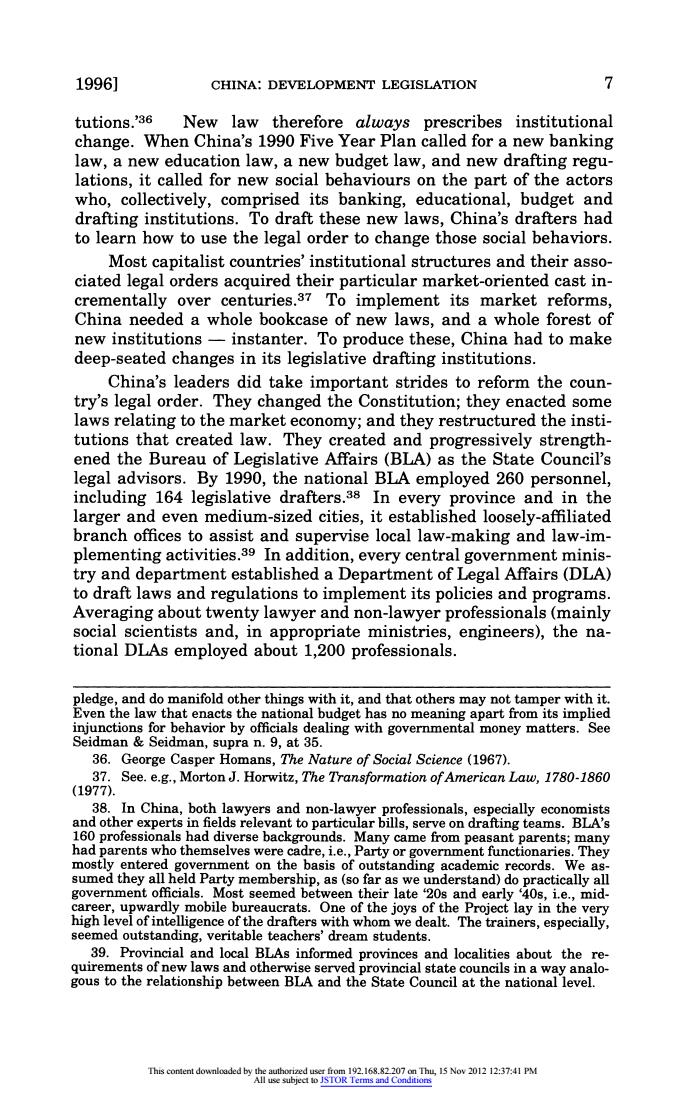正在加载图片...

1996] CHINA:DEVELOPMENT LEGISLATION 7 tutions.'36 New law therefore always prescribes institutional change.When China's 1990 Five Year Plan called for a new banking law,a new education law,a new budget law,and new drafting regu- lations,it called for new social behaviours on the part of the actors who,collectively,comprised its banking,educational,budget and drafting institutions.To draft these new laws,China's drafters had to learn how to use the legal order to change those social behaviors. Most capitalist countries'institutional structures and their asso- ciated legal orders acquired their particular market-oriented cast in- crementally over centuries.37 To implement its market reforms, China needed a whole bookcase of new laws,and a whole forest of new institutions-instanter.To produce these,China had to make deep-seated changes in its legislative drafting institutions. China's leaders did take important strides to reform the coun- try's legal order.They changed the Constitution;they enacted some laws relating to the market economy;and they restructured the insti- tutions that created law.They created and progressively strength- ened the Bureau of Legislative Affairs(BLA)as the State Council's legal advisors.By 1990,the national BLA employed 260 personnel, including 164 legislative drafters.38 In every province and in the larger and even medium-sized cities,it established loosely-affiliated branch offices to assist and supervise local law-making and law-im- plementing activities.39 In addition,every central government minis- try and department established a Department of Legal Affairs(DLA) to draft laws and regulations to implement its policies and programs. Averaging about twenty lawyer and non-lawyer professionals(mainly social scientists and,in appropriate ministries,engineers),the na- tional DLAs employed about 1,200 professionals. pledge,and do manifold other things with it,and that others may not tamper with it. Even the law that enacts the national budget has no meaning apart from its implied injunctions for behavior by officials dealing with governmental money matters.See Seidman Seidman,supra n.9,at 35. 36.George Casper Homans,The Nature of Social Science (1967). 37.See.e.g.,Morton J.Horwitz,The Transformation of American Law,1780-1860 (1977). 38.In China,both lawyers and non-lawyer professionals,especially economists and other experts in fields relevant to particular bills,serve on drafting teams.BLA's 160 professionals had diverse backgrounds.Many came from peasant parents;many had parents who themselves were cadre,i.e.,Party or government functionaries.They mostly entered government on the basis of outstanding academic records.We as- sumed they all held Party membership,as(so far as we understand)do practically all government officials.Most seemed between their late '20s and early 40s,i.e.,mid- career,upwardly mobile bureaucrats.One of the joys of the Project lay in the very high level of intelligence of the drafters with whom we dealt.The trainers,especially, seemed outstanding,veritable teachers'dream students. 39.Provincial and local BLAs informed provinces and localities about the re- quirements of new laws and otherwise served provincial state councils in a way analo- gous to the relationship between BLA and the State Council at the national level. This content downloaded by the authorized user from 192.168.82 207 on Thu,15 Nov 2012 12:37:41 PM All use subject to JSTOR Terms and Conditions1996] CHINA: DEVELOPMENT LEGISLATION 7 tutions.'36 New law therefore always prescribes institutional change. When China's 1990 Five Year Plan called for a new banking law, a new education law, a new budget law, and new drafting regulations, it called for new social behaviours on the part of the actors who, collectively, comprised its banking, educational, budget and drafting institutions. To draft these new laws, China's drafters had to learn how to use the legal order to change those social behaviors. Most capitalist countries' institutional structures and their associated legal orders acquired their particular market-oriented cast incrementally over centuries.37 To implement its market reforms, China needed a whole bookcase of new laws, and a whole forest of new institutions - instanter. To produce these, China had to make deep-seated changes in its legislative drafting institutions. China's leaders did take important strides to reform the country's legal order. They changed the Constitution; they enacted some laws relating to the market economy; and they restructured the institutions that created law. They created and progressively strengthened the Bureau of Legislative Affairs (BLA) as the State Council's legal advisors. By 1990, the national BLA employed 260 personnel, including 164 legislative drafters.38 In every province and in the larger and even medium-sized cities, it established loosely-affiliated branch offices to assist and supervise local law-making and law-implementing activities.39 In addition, every central government ministry and department established a Department of Legal Affairs (DLA) to draft laws and regulations to implement its policies and programs. Averaging about twenty lawyer and non-lawyer professionals (mainly social scientists and, in appropriate ministries, engineers), the national DLAs employed about 1,200 professionals. pledge, and do manifold other things with it, and that others may not tamper with it. Even the law that enacts the national budget has no meaning apart from its implied injunctions for behavior by officials dealing with governmental money matters. See Seidman & Seidman, supra n. 9, at 35. 36. George Casper Homans, The Nature of Social Science (1967). 37. See. e.g., Morton J. Horwitz, The Thansformation ofAmerican Law, 1780-1860 (1977). 38. In China, both lawyers and non-lawyer professionals, especially economists and other experts in fields relevant to particular bills, serve on drafting teams. BLA's 160 professionals had diverse backgrounds. Many came from peasant parents; many had parents who themselves were cadre, i.e., Party or government functionaries. They mostly entered government on the basis of outstanding academic records. We assumed they all held Party membership, as (so far as we understand) do practically all government officials. Most seemed between their late '20s and early '40s, i.e., midcareer, upwardly mobile bureaucrats. One of the joys of the Project lay in the very high level of intelligence of the drafters with whom we dealt. The trainers, especially, seemed outstanding, veritable teachers' dream students. 39. Provincial and local BLAs informed provinces and localities about the requirements of new laws and otherwise served provincial state councils in a way analogous to the relationship between BLA and the State Council at the national level. This content downloaded by the authorized user from 192.168.82.207 on Thu, 15 Nov 2012 12:37:41 PM All use subject to JSTOR Terms and Conditions